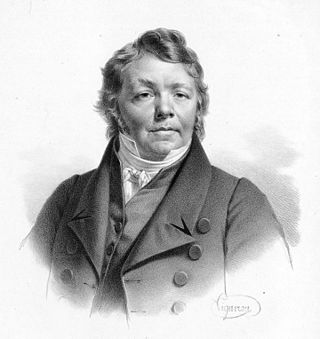Related Research Articles
This is a list of music-related events in 1820.
This article is about music-related events in 1822.
This article is about music-related events in 1824.

Johann Nepomuk Hummel was an Austrian composer and virtuoso pianist. His music reflects the transition from the Classical to the Romantic musical era. He was a pupil of Mozart, Salieri and Clementi. He also knew Beethoven and Schubert.

A piano concerto, a type of concerto, is a solo composition in the classical music genre which is composed for piano accompanied by an orchestra or other large ensemble. Piano concertos are typically virtuosic showpieces which require an advanced level of technique. Piano Concertos are typically written out in music notation, including sheet music for the pianist, orchestral parts, and a full score for the conductor.
Piano Concerto No. 3 refers to the third piano concerto written by one of a number of composers:
Cyclic form is a technique of musical construction, involving multiple sections or movements, in which a theme, melody, or thematic material occurs in more than one movement as a unifying device. Sometimes a theme may occur at the beginning and end ; other times a theme occurs in a different guise in every part.

Ferdinand Ries was a German composer. Ries was a friend, pupil and secretary of Ludwig van Beethoven. He composed eight symphonies, a violin concerto, nine piano concertos, three operas, and numerous other works, including 26 string quartets. In 1838 he published a collection of reminiscences of his teacher Beethoven, co-written with Franz Wegeler. The symphonies, some chamber works—most of them with piano—his violin concerto and his piano concertos have been recorded, exhibiting a style which, given his connection to Beethoven, lies between the Classical and early Romantic styles.
E major is a major scale based on E, consisting of the pitches E, F♯, G♯, A, B, C♯, and D♯. Its key signature has four sharps. Its relative minor is C-sharp minor and its parallel minor is E minor. Its enharmonic equivalent, F-flat major, has six flats and the double-flat B, which makes it impractical to use.
A-flat major is a major scale based on A♭, with the pitches A♭, B♭, C, D♭, E♭, F, and G. Its key signature has four flats.
D-flat major is a major scale based on D♭, consisting of the pitches D♭, E♭, F, G♭, A♭, B♭ and C. Its key signature has five flats. It is enharmonically equivalent to C-sharp major.
C-sharp minor is a minor scale based on C♯, with the pitches C♯, D♯, E, F♯, G♯, A, and B. Its key signature consists of four sharps.
Johann Nepomuk Hummel's Piano Concerto No. 3 in B minor, Op. 89 was composed in Vienna in 1819 and published in Leipzig in 1821.
Johann Nepomuk Hummel's Piano Concerto No. 2 in A minor, Op. 85 was written in 1816 and published in Vienna in 1821. Unlike his earlier piano concerti, which closely followed the model of Mozart's, the A minor concerto, like his Piano Concerto No. 3 in B minor, Op. 89, is written in a proto-Romantic style that anticipates the later stylistic developments of composers such as Frédéric Chopin, Franz Liszt and Felix Mendelssohn.
Felix Mendelssohn's Sextet in D major, Op. 110, MWV Q 16, for piano, violin, two violas, cello, and double bass was composed in April–May 1824, when Mendelssohn was only 15, the same time he was working on a comic opera Die Hochzeit des Camacho. Its composition took place between the Viola Sonata and the Piano Quartet No. 3. It also preceded the famous Octet, Op. 20 by about a year. 1824 is also the probable year of the composition of the Clarinet Sonata. Like the latter, the Sextet was not published during the composer's lifetime. Its first edition was issued in 1868 as a part of a complete collection of Mendelssohn's works. Hence the misleading high opus number.

The Piano Concerto No. 6 in C major, Op. 123, by Ferdinand Ries was composed around 1806. Composed in a proto-Romantic style, similar to the concertos of Johann Nepomuk Hummel, it also shows evidence of the influence of Beethoven's C minor Piano Concerto, Op. 37 which Ries had performed at his public debut in 1804.
The Piano Concerto No. 8 in A-flat major, Op. 151 "Gruss an den Rhein", by Ferdinand Ries was composed around 1826 and published in 1829 by Simrock. While still showing the structural influence of Beethoven's piano concertos, the writing for the piano is more akin to that of later composers such as Chopin, Mendelssohn & Schumann.
The Piano Concerto No. 5 in D major, Op. 120 "Concerto Pastorale", by Ferdinand Ries was composed between 1813-1816 and published in 1823 by the firm of Sauer & Leidesdorf with a dedication to Prince Oscar of Sweden.
The Piano Concerto No. 4 in C minor, Op. 115 by Ferdinand Ries was composed in Bonn in 1809 but was not published until 1823 when it was released by both H.A. Probst of Leipzig and Birchall & Cº of London with a dedication to Ignaz Moscheles.
References
- Notes
- ↑ Bradley 2007
- ↑ Verzeichniss von Musikalien welche in der Falterschen Musikhandlung at Google Books, by Falterische Musikhandlung
- ↑ Walker, Alan. Franz Liszt, The Virtuoso Years,1811-1847, Cornell University Press, 1983, pp.58-9.
- Sources
- Badley, Allan (2007). Ries, F.: Piano Concertos, Vol. 2 - No. 3/Introduction and Polonaise/Variations on Swedish National Airs (CD). Naxos Records. 8.557844.
- McGorray, Ian (2015-07-21). Ferdinand Ries and the Piano Concerto: Beethoven's Shadow and the Early Romantic Concerto (M.M.). University of Cincinnati.